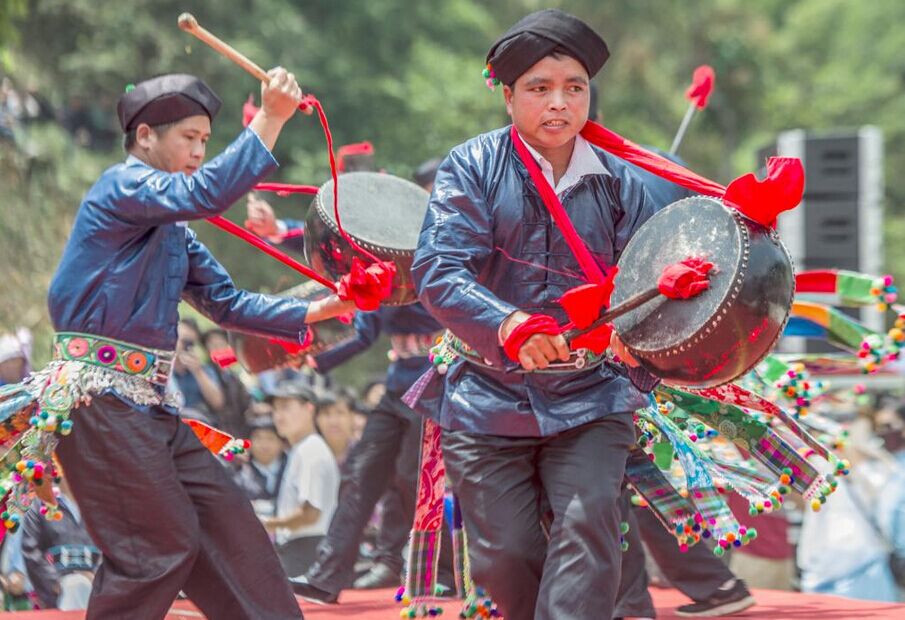

Zhuang Ethnic Minority


has the largest population (almost 18 million) among all the 55 ethnic groups in China. Most of them inhabit in Guangxi Zhuang Autonomous Region and Yunnan Province. In Guangdong, Hunan, Guizhou and Sichuan provinces of South China, there is also some distribution of Zhuang People.The Zhuang ethnic group has its own language, which is generally divided into northern and southern dialects. In 1953, the Chinese Government launched a new language system of Zhuang characters based on Latin alphabet, but it was not widely used. Most people use Han-Chinese characters.The Zhuang nationality mostly worships the nature and their ancestors. After the Tang (618–907) and Song Dynasties (960–1279), both Buddhism and Taoism were spread to Zhuang areas, and temples of Buddhism and Taoism were built. Catholicism and Protestantism were introduced later, but their influence was limited.HistoryAs early as Paleolithic period, first men of Zhuang had settled in Lingnan areas (whole of Guangxi and Guangdong Provinces, parts of Jiangxi and Hunan Provinces). They lived and labored together, and were able to use stone tools.Eating HabitsRice and corn are abundantly grown in Zhuang areas, and thus become the staple food for Zhuang people. Daily consumed vegetables are numerous, and are boiled into soup, or stir-fired. Zhuang people basically eat all kinds of meat. Meat and vegetables are cooked medium well, which is believed to retain the fresh tasting of the materials. Home-made pickles are also popular because of people’s preference for sour and spicy flavors.Home-made rice wine is served for festivals and entertaining guests. Rice wine is mild and contains low amount of alcohol. Five-colored glutinous rice is served during Tomb-Sweeping Day (April 4 - 6) and Singing Festival (March 3 on lunar calendar). People use the saps of five different plants to soak and color the glutinous rice, till the rice take on five colors (black, red, yellow, purple and white), and then steam the rice. The finished rice is colorful, fragrant and nutritious.Architectural Style
Zhuang housesZhuang people like to inhabit on valley lands surrounded by mountains and waters. The house facade faces the farmland, and is well-lighted with a broad view. Houses are wooden, tile-roofed, or thatched, built in Ganlan style (constructed on pilings rather than entirely on the ground). Ganlan is also called Diaojiaolou (wooden houses projecting over the water). Some other ethnic groups in South China, such as Zhuang, Dong, Miao and Yao ethnic groups also share this house style.The house is usually two-storied. The lower story consists of pilings that support the house, and bamboos, wood boards are filled between the pilings to form a wall for keeping livestock, storing farm tools, firewood or other sundries. Family members live on the upper story, which is divided into 3 or 5 rooms. Some houses are more complicated with lofts or annexes.Costumes and HandicraftsTraditional costumes are worn in ethnic areas or for special occasions. Dexterous Zhuang women use hand-woven fabric to make clothes of various styles. Usually girls wear a blue-and-black collarless jacket with bright furbelow, baggy trousers or Batik skirt, and a delicately embroidered apron is fastened on the waist. For boys, they are dressed in black front-opening coat with cloth-wrapped buttons, and wear a belt on the waist. Zhuang people fancy silver accessories.Zhuang Brocade is one of the four famous Chinese brocades (the other three are: Yun Brocade from Nanjing, Shu Brocade from Sichuan Province, and Song Brocade from Suzhou). This splendid handicraft was originated in the Song Dynasty (960 – 1276 AD). They are woven with cotton, silk or flax threads into colorful patterns. Images of flowers, plants and animals are mostly adopted. The Brocade is very durable, and is widely used in making quilt covers, handbags, aprons, table-cloth, scarves, wall hangings, cushions, etc.
Xiuqiu (silk balls), are symbols of love and happiness for the Zhuang PeopleAnother traditional handicraft of the Zhuang ethnic group is Xiuqiu (embroidery ball), a symbol of love and happiness. The balls are made of silk cloth, and have twelve connected petals. Each petal represents a month, and has an image of flowers, plants, or birds on it. The balls are typically red, yellow or green. Originally Xiuqiu are a love gift, a Zhuang girl will throw a Xiuqiu to a young man she admires to let him know that he is welcome to pursue her.
You will only receive emails that you permitted upon submission and your email address will never be shared with any third parties without your express permission.
